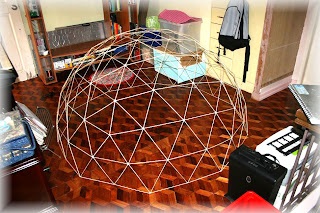Four days ago I posted this article up depicting how you can create your very own geodesic dome - using barbecue sticks! Chicken barbecue sticks, that is. The ones that are up to 30cm long.
It actually took me around a month and a half to finish since I had to keep postponing construction, though in theory I could've taken only a week, had I not been doing anything else. It was very tedious repeating the same task which was just to measure, cut and glue together all 250 sticks into 30 nets. And because I'm living in a tropical area, I had the air conditioner running while I was using the glue gun so the glue would dry faster. It was even more challenging when I had to put the whole thing together with string, and had to be in all sorts of positions (mostly sitting on the floor). At one point I had to redo tying up one net because it was incorrectly placed.
One of the drawbacks of this dome is that the joints where it is tied with string, can easily dislocate even when tightly wound, but this proves to be advantageous in terms of its level of flexibility, allowing it to be crumpled and passed through the door, then spring back to its original form.
I was thinking of using clay for the joints, and also using an underneath dome layer (space frame) for additional structural support, but I thought it would be even more complicated, and that's something I'd have to test for next time. Another one of my future attempts would be to make it out of bamboo sticks, though I'd need to work outside and have a free large open ground to use. Hmm, wonder if I could get hold of memory metal. That would be interesting.
For about a week the dome was basically taking over 2/3 of my entire room, with me just sleeping in the corner next to the door exit, so I thought enough's enough and decided to crumple it up and stand it upright in a corner. Now it looks like a giant geodesic cocoon sculpture awaiting to collect dust.
 |
| I think this can be an interesting structure for a new building |
Well at least I've figured out how to make these things (and now you can too) =)
































